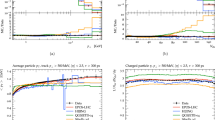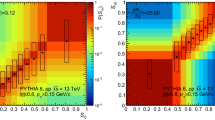Abstract
Transverse momentum spectra (\(p_T\)) of charged particles including \(\pi ^{\pm }\), \(K^{\pm }\) and (anti-)protons measured by ALICE experiment in the \(p_T\) range of 0.1–2.5 GeV/c and \(|\eta |\) < 0.5 are studied in pp collisions at \(\sqrt{s}\) = 900 GeV using modified Hagedorn function with embedded transverse flow velocity and are compared to the predictions of EPOS–LHC, Pythia, QGSJET and Sibyll models. We find that the average transverse flow velocity (\(\beta _T\)) decreases with increasing the mass of the particle, while the kinetic freeze-out temperature (\(T_{0}\)) extracted from the function increases with the particle’s mass. The former varies from (0.36 ± 0.01) c to (0.25 ± 0.01) c for \(\pi ^{\pm }\) to protons, while the latter from (76 ± 6) MeV to (95 ± 5) MeV, respectively. The fit of the models predictions also yields the same values for \(T_{0}\) and \(\beta _T\) as the experimental data. The only difference is in the values of n and \(N_0\) which yields different values for different models. The EPOS–LHC, Pythia and QGSJET models reproduce the data in most of the \(p_{T}\) range for \(\pi ^{\pm }\), EPOS–LHC and Sibyll for \(K^{\pm }\) up to 1.5 GeV/c and EPOS–LHC for protons up to 1.6 GeV/c. The model simulations also reproduced the behavior of increasing average transverse momentum with mass reported by the ALICE experiment.



Similar content being viewed by others
References
K. Akiba et al., J. Phys. G 43, 110201 (2016)
C.M.S. Collaboration, Eur. Phys. J. C 75, 237 (2015). https://doi.org/10.1140/epjc/s10052-015-3435-4
ALICE Collaboration, Phys. Lett. B 736, 196 (2014). https://doi.org/10.1016/j.physletb.2014.07.011
E. Schnedermann, J. Solfrank, Phys. Rev. C 48, 2462 (1993)
STAR Collab, B. I. Abelev et al., Phys. Rev. C 81: 024911, (2010)
H.L. Lao et al., Eur. Phys. J. A 53, 44 (2017)
T. Bhattacharyya et al., Eur. Phys. J. A 52, 30 (2016)
P.K. Khandai et al., J. Phys. G 41, 025105 (2014)
Kh.K. Olimov et al., Mod. Phys. Lett. A 35, 2050237 (2020)
Kh.K. Olimov et al., Mod. Phys. Lett. A 35, 2050115 (2020)
B. Abelev et al., ALICE Collaboration. Phys. Rev. C 88, 044910 (2013)
M. Ajaz et al., Int. J. Theor. Phys. 59, 3338 (2020)
M. Ajaz, M. Tufail, Y. Ali, Arab. J. Sci. Eng. 45, 411 (2020). https://doi.org/10.1007/s13369-019-04224-8
R. Khan, M. Ajaz, Mod. Phys. Lett. A 35, 2050190 (2020)
M. Ajaz, R. Khan, Y. Ali, M.K. Suleymanov, Mod. Phys. Lett. A 35, 1950349 (2020)
S. Ullah, M. Ajaz, Z. Wazir, Y. Ali, K.H. Khan, H. Younis, Sci. Rep. 9, 11811 (2019)
S. Ullah, M. Ajaz, Y. Ali, Europhys. Lett. 123, 31001 (2018)
S. Ullah, Y. Ali, M. Ajaz, U. Tabassam, Q. Ali, Int. J. Mod. Phys. A 33, 1850108 (2018)
K. Aamodt et al., ALICE Collaboration, Eur. Phys. J. C 71, 1655 (2011)
T. Pierog, I. Karpenko, J.M. Katzy, E. Yatsenko, K. Werner, Phys. Rev. C 92, 034906 (2015)
T. Sjostrand, S. Mrenna, P. Skand, Pythia 6.4 Physics and manual. JHEP 05, 026 (2006)
S. Ostapchenko, Phys. Rev. D 83, 014018 (2011)
S. Ostapchenko, Nucl. Phys. B Proc. Suppl. 151, 143–146 (2006)
F. Riehn et al., Phys. Rev. D 102, 063002 (2020)
K. Werner et al., Phys. Rev. C 74, 044902 (2006)
K. Werner, Phys. Rev. Lett. 98, 152301 (2007)
A.B. Kaidalov, K.A. Ter-Martirosyan, Sov. J. Nucl. Phys. 39, 979 (1984)
P.K. Khandai et al., J. Phys. G: Nucl. Part. Phys. 41, 025105 (2014)
M. Waqas et al., Indian J. Phys. 93, 1329–1343 (2019)
M. Waqas et al., Eur. Phys. J. A 56, 188 (2020)
M. Waqas et al., Int. J. Mod. Phys. E 30, 2150061 (2021)
M. Ajaz et al., Results Phys. 30, 104790 (2021)
M. Waqas et al., J. Phy. G 48, 075108 (2021)
Author information
Authors and Affiliations
Corresponding author
Rights and permissions
About this article
Cite this article
Ajaz, M., Waqas, M., Peng, G.X. et al. Study of \(p_{T}\) spectra of light particles using modified Hagedorn function and cosmic rays Monte Carlo event generators in proton–proton collisions at \(\sqrt{s}\) = 900 GeV. Eur. Phys. J. Plus 137, 52 (2022). https://doi.org/10.1140/epjp/s13360-021-02271-5
Received:
Accepted:
Published:
DOI: https://doi.org/10.1140/epjp/s13360-021-02271-5




